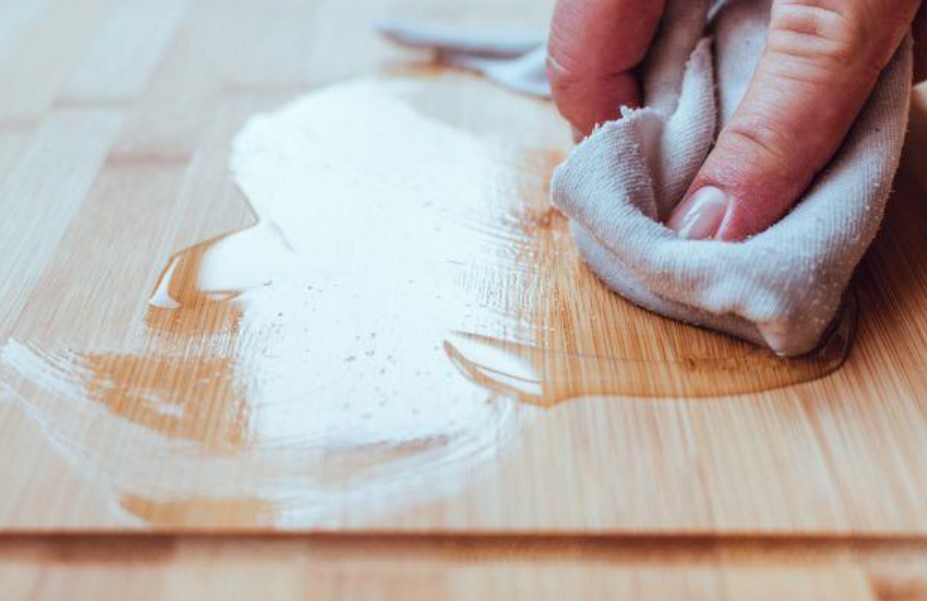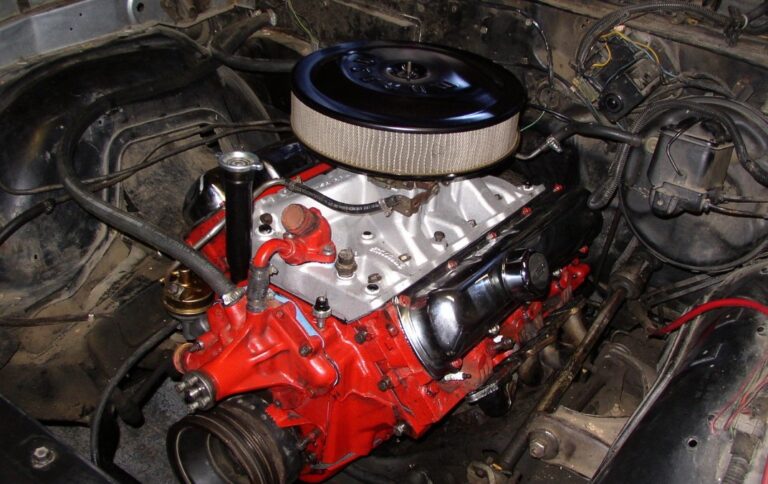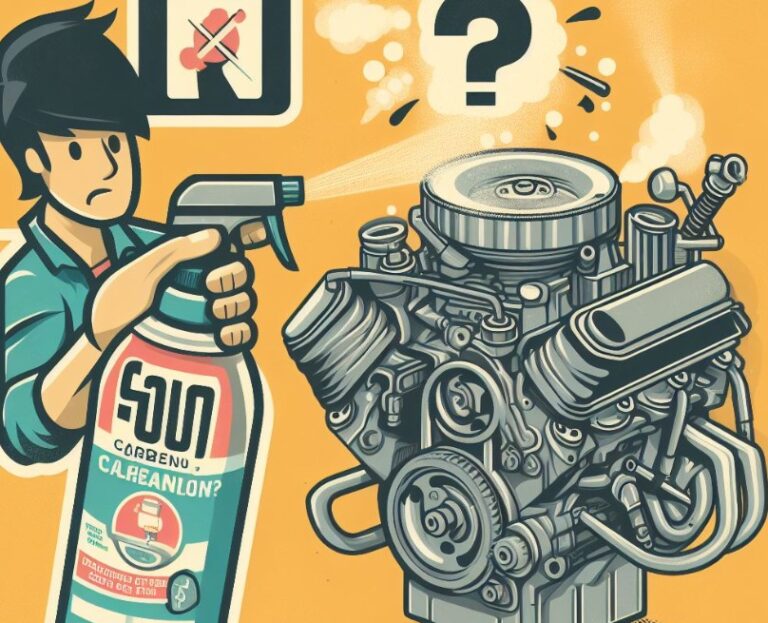How To Get Engine Oil Out Of Wood? Remove Oil In 7 Steps
In this article, we’ll explain How To Get Engine Oil Out Of Wood? Removing engine oil from wood can be a challenging task, but with the right techniques and materials, it is possible to restore the wood to its original condition. This comprehensive guide will provide you with detailed steps and tips to effectively remove engine oil stains from wood surfaces.
Key Takeaways
- Act quickly to prevent the oil from penetrating deeply into the wood.
- Use absorbent materials like baking soda or cat litter for initial cleanup.
- Apply a degreaser or dish soap solution for further cleaning.
- Sanding may be necessary for stubborn stains.
- Protect the wood with appropriate finishes after cleaning.
How To Get Engine Oil Out Of Wood?
Removing engine oil from wood involves several detailed steps. Each step is crucial for effectively eliminating the stain while preserving the integrity of the wood. Here’s a comprehensive guide:

- Blot the Spill:
- Action: If the oil spill is fresh, immediately blot it up using absorbent paper towels or a clean cloth.
- Purpose: This step is vital to remove as much oil as possible before it seeps deeper into the wood grain.
- Caution: Avoid rubbing the spill, as this can spread the oil and push it further into the wood.
- Apply an Absorbent Material:
- Choice of Absorbents: Use baking soda, cat litter, or sawdust. These materials are effective at absorbing oil.
- Application: Generously cover the oil-stained area with the chosen absorbent.
- Duration: Leave it on the stain for several hours, preferably overnight, to absorb the oil.
- Removal: Afterward, carefully sweep or vacuum up the absorbent material.
- Clean with a Degreasing Solution:
- Preparing the Solution: Mix dish soap with warm water. Dish soap is a mild degreaser and is safe for most wood finishes.
- Application: Apply the soapy solution to the stained area using a sponge or cloth.
- Scrubbing: Gently scrub the area in a circular motion to break down the oil residue.
- Rinsing: Rinse the area with clean water to remove any soap residue.
- Drying: Dry the wood thoroughly with a clean towel.
- Sanding the Stained Area (if needed):
- When to Sand: If the stain persists after cleaning, light sanding may be necessary.
- Tool Selection: Use fine-grit sandpaper to avoid damaging the wood surface.
- Technique: Gently sand the stained area in the direction of the wood grain.
- Progress Checking: Frequently check your progress to ensure the stain is being removed and not just the wood surface.
- Refinishing the Area:
- Need for Refinishing: Sanding can remove the wood’s finish, so refinishing might be required.
- Choosing the Finish: Select a finish that matches the rest of the wood.
- Application: Apply the finish according to the manufacturer’s instructions, usually with a brush or cloth.
- Drying: Allow the finish to dry completely before using the surface.
- Preventive Measures for Future Spills:
- Sealing the Wood: Apply a sealant or varnish to create a protective layer over the wood.
- Regular Maintenance: Clean up spills immediately and keep the wood surface clean and dry.
- Disposal of Cleaning Materials:
- Safety: Dispose of used rags, paper towels, and absorbents safely, as they can be flammable.
Each of these steps is designed to tackle different aspects of the oil removal process, ensuring that the wood is cleaned effectively without causing damage. The information is sourced from woodworking and DIY experts who regularly deal with similar challenges.
Effective Cleaning Solutions
Immediate Actions
Act quickly: As soon as you notice the oil spill, it’s crucial to act fast. The longer the oil sits on the wood, the deeper it will penetrate, making it harder to remove.
Absorbing the Oil
Use absorbents: Materials like baking soda, cat litter, or sawdust are excellent for absorbing oil. Generously sprinkle the absorbent over the oil spill, and let it sit for several hours or overnight. Sweep or vacuum up the absorbent material.
Applying Cleaning Agents

Using Degreasers
Choose a degreaser: Commercial degreasers or a solution of dish soap and water can be effective in breaking down the oil. Apply the solution to the stained area and let it sit for a few minutes before wiping it off.
Natural Alternatives
Vinegar solution: For a more natural approach, mix equal parts of vinegar and water. Apply this solution to the stain and gently rub it in with a soft cloth.
Advanced Cleaning Techniques
Sanding the Wood
Sanding for stubborn stains: If the stain persists, sanding may be necessary. Use fine-grit sandpaper and gently sand the stained area. Be sure to sand evenly to avoid creating depressions in the wood.
Restoring the Wood
Refinishing: After removing the stain, it’s important to restore the wood’s finish. Apply a wood stain or sealant to protect the surface and enhance its appearance.
Preventive Measures
Regular Maintenance
Clean spills immediately: Always clean up oil spills as soon as they occur to prevent the oil from seeping into the wood.
Protective Coatings
Apply sealants: Use sealants or varnishes to create a protective layer on the wood, making it less susceptible to staining.
Is Engine Oil Bad For Wood?
Engine oil can be detrimental to wood, primarily because it is a hydrophobic liquid that penetrates deeply into the wood’s porous structure. When engine oil spills on wood, it seeps into the pores and can cause several issues:

- Staining: The most immediate effect of engine oil on wood is staining. The oil leaves a dark, often unsightly mark that can be difficult to remove, especially if not addressed quickly.
- Degradation: Over time, engine oil can break down the lignin and cellulose in wood. This breakdown can lead to a weakening of the wood’s structural integrity, making it more prone to damage and decay.
- Odor: Engine oil has a strong, persistent odor that can be absorbed by the wood, making the affected area unpleasant to be near.
- Difficulty in Refinishing: Once the wood is stained with oil, it becomes more challenging to refinish or repaint, as the oil creates a barrier that can prevent new finishes from adhering properly.
To protect wood surfaces from the harmful effects of engine oil, it’s crucial to clean spills promptly and thoroughly. Additionally, applying a sealant to wood can provide a barrier that prevents oil from penetrating deeply.
How Do You Remove Motor Oil From Wood?
Removing motor oil from wood involves a multi-step process to ensure that the stain is thoroughly cleaned without damaging the wood. Here are the steps:

- Blotting the Spill: Firstly, if the spill is recent, blot up as much oil as possible using paper towels or a clean, dry cloth. Avoid rubbing, as this can push the oil deeper into the wood.
- Applying an Absorbent: Sprinkle an absorbent material like baking soda, cat litter, or sawdust on the stain. These substances help draw the oil out of the wood. Leave the absorbent on the stain for several hours or overnight, then sweep or vacuum it up.
- Cleaning with a Degreaser: Apply a degreaser or a solution of dish soap and warm water to the stain. Dish soap is effective because it breaks down the oil, making it easier to remove. Scrub gently with a soft brush or cloth, then rinse with clean water.
- Sanding the Area: If the stain persists, sanding may be necessary. Use fine-grit sandpaper to gently sand the stained area, being careful not to sand too deeply, which could damage the wood.
- Refinishing the Wood: After removing the stain, it might be necessary to refinish the area to match the rest of the wood surface. Apply a wood stain or sealant as needed.
- Preventive Measures: To prevent future stains, apply a sealant or varnish to the wood. This creates a protective layer that makes the wood less susceptible to oil stains.
Conclusion
Effectively removing engine oil from wood requires prompt action, the right cleaning materials, and a bit of patience. By following the steps outlined in this guide, you can successfully restore your wood surfaces to their original state.
Remember, prevention is key; regular maintenance and protective coatings can go a long way in keeping your wood surfaces free from oil stains.
Frequently Asked Questions
Is it possible to remove old, set-in oil stains from wood?
Removing old, set-in oil stains can be challenging. Start with a degreaser or dish soap solution, and if that doesn’t work, try sanding the area. For very old or deep stains, professional restoration might be the best option.
What should I do if the oil stain persists after cleaning?
If the stain persists, you might need to repeat the cleaning process or resort to sanding. If sanding doesn’t work, consulting a professional may be necessary.
Can oil stains on wood lead to long-term damage?
If left untreated, oil stains can penetrate deeply into the wood and cause discoloration and deterioration over time. Prompt cleaning is essential to prevent long-term damage.
Is it necessary to refinish the wood after removing the oil stain?
Refinishing may be necessary if the cleaning process has altered the wood’s appearance or if the surface finish has been removed during cleaning. Applying a wood stain or sealant can restore its look and provide protection.
How can I prevent future engine oil stains on wood?
To prevent future stains, apply a sealant or varnish to create a protective layer on the wood. Also, clean up any oil spills immediately to prevent the oil from seeping into the wood.

Welcome to the exhilarating world of Matt Rex, a professional car racer turned renowned vehicle enthusiast. Immerse yourself in his captivating blog as he shares heart-pounding adventures, expert reviews, and valuable insights on cars, trucks, jets, and more. Fuel your passion for speed and discover the beauty of vehicles through Matt’s engaging stories and meticulous expertise. Join the ever-growing community of enthusiasts who find inspiration and expert advice in Matt Rex’s blog—a digital hub where the thrill of speed meets the pursuit of knowledge.






![Can ABS Cause Brake Pedal To Go To The Floor? [Answered]](https://www.turbochaos.com/wp-content/uploads/2023/09/Can-ABS-Cause-Brake-Pedal-To-Go-To-The-Floor.jpg)
